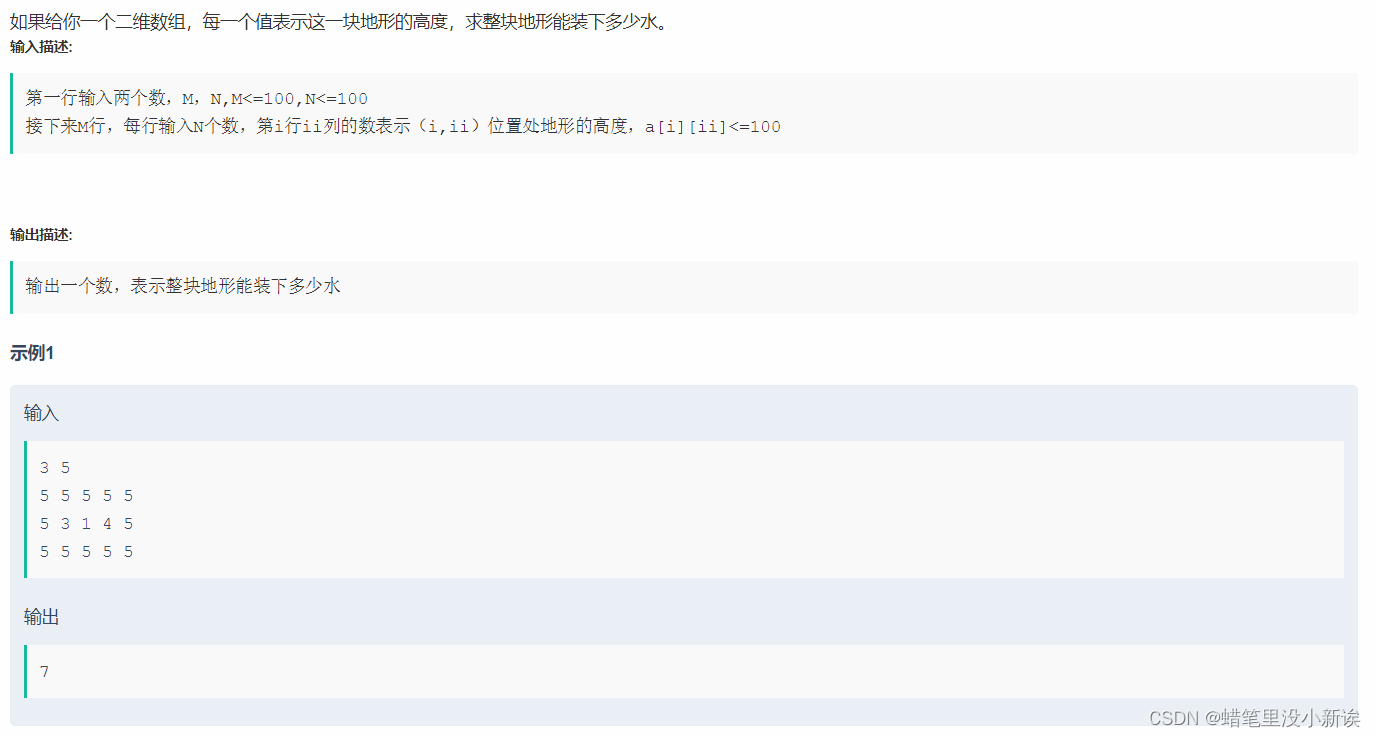地形盛水(题目来自牛客网)

思路解读
设置变量:
bf 字符流缓冲区
n,m 矩阵的行和列
heightMap 水位二维数组
Node 每一个方框
Node.row 方框的行号
Node.col 方框的列号
Node.value 方框的水位值
ans 输出结果
max 当前水位的阀值
N,M 同 n,m
isEnter 标识是否已经进过堆的二维boolean型数组
heap 小根堆
设置小根堆,小根堆按照水位高度从小排到大,小根堆实际上就是优先级队列PriorityQueue,按照从小到大进行排列,先将整个边框进堆,即最外层的数据先进队列,然后从中挑选最小的的方格,该方格为当前的阀值,即最低点,初始设置一个最大值max,若当前挑选出来的方格的水位比最大值max高,则更新max的值为当前挑选出来的方框的水位值,然后将max与当前方框的上下左右放款进行比较,若比当前max的值小,则计算水位差,加入最终结果ans,将该方框进堆,且标志该方框为已经进过堆,即isEnter = true,若比当前max的值大,则直接进堆,并修改该方框的isEnter = true,表示已经进过堆。若堆不为空,则继续寻找最小方框,反复,直到堆为空。
AC代码
import java.io.BufferedReader;
import java.io.InputStreamReader;
import java.util.Comparator;
import java.util.PriorityQueue;
public class Main {
static BufferedReader bf = new BufferedReader(new InputStreamReader(System.in));
public static void main(String[] args) throws Exception{
String [] s = bf.readLine().split(" ");
int n = Integer.parseInt(s[0]);
int m = Integer.parseInt(s[1]);
int [][] heightMap = new int[n][m];
for(int i=0;i<n;i++) {
s = bf.readLine().split(" ");
for(int j=0;j<m;j++) {
heightMap[i][j] = Integer.parseInt(s[j]);
}
}
System.out.println(Main.trapRainWater(heightMap));
}
public static class Node {
public int value;
public int row;
public int col;
public Node(int row, int col, int value) {
this.row = row;
this.col = col;
this.value = value;
}
}
public static int trapRainWater(int [][] heightMap) {
int ans = 0;
int max = 0;
if(heightMap == null || heightMap.length == 0 || heightMap[0] == null || heightMap[0].length == 0) {
return 0;
}
int N = heightMap.length;
int M = heightMap[0].length;
boolean [][] isEnter = new boolean[N][M];
// 优先级队列就是一个小根堆
PriorityQueue<Node> heap = new PriorityQueue<Node>(new NodeComparator());
for(int col = 0; col < M - 1; col++) {
isEnter[0][col] = true;
heap.add(new Node(0,col,heightMap[0][col]));
}
for(int row = 0; row < N - 1; row++) {
isEnter[row][M-1] = true;
heap.add(new Node(row,M-1,heightMap[row][M-1]));
}
for(int col = M - 1; col > 0; col--) {
isEnter[N-1][col] = true;
heap.add(new Node(N-1,col,heightMap[N-1][col]));
}
for(int row = N - 1; row > 0; row--) {
isEnter[row][0] = true;
heap.add(new Node(row,0,heightMap[row][0]));
}
while(!heap.isEmpty()) {
Node node = heap.poll();
int value = node.value;
int row = node.row;
int col = node.col;
if (value > max)
max = value;
if(row - 1 >= 0 && !isEnter[row - 1][col]) {
isEnter[row - 1][col] = true;
if(heightMap[row - 1][col] < max) {
ans += max - heightMap[row - 1][col];
}
heap.add(new Node(row - 1, col, heightMap[row - 1][col]));
}
if(col - 1 >= 0 && !isEnter[row][col - 1]) {
isEnter[row][col - 1] = true;
if(heightMap[row][col - 1] < max) {
ans += max - heightMap[row][col - 1];
}
heap.add(new Node(row, col - 1, heightMap[row][col - 1]));
}
if(row + 1 < N && !isEnter[row + 1][col]) {
isEnter[row + 1][col] = true;
if(heightMap[row + 1][col] < max) {
ans += max - heightMap[row + 1][col];
}
heap.add(new Node(row + 1, col, heightMap[row + 1][col]));
}
if(col + 1 < M && !isEnter[row][col + 1]) {
isEnter[row][col + 1] = true;
if(heightMap[row][col + 1] < max) {
ans += max - heightMap[row][col + 1];
}
heap.add(new Node(row, col + 1, heightMap[row][col + 1]));
}
}
return ans;
}
public static class NodeComparator implements Comparator<Node> {
@Override
public int compare(Node o1, Node o2) {
return o1.value - o2.value;
}
}
}
























 被折叠的 条评论
为什么被折叠?
被折叠的 条评论
为什么被折叠?










